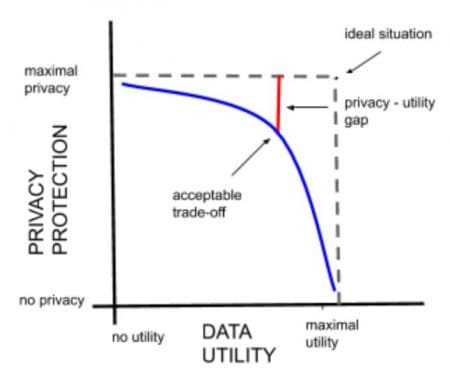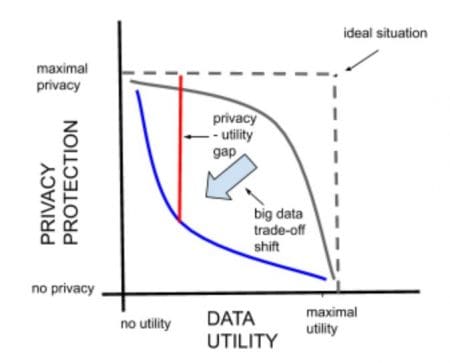Don't break things
In the first part of this PrivacyTech in Banking series, I looked into the effect that privacy has on data-driven innovation in the financial services industry. Moving fast and breaking things is extremely bad advice when it comes to privacy. The main reason why privacy turns out to be a killer of your data-driven innovation project lies in the fact that privacy is closely related to trust - the most valuable asset a financial institution has (to lose). But privacy protection stays tricky even if the banks don’t try to cut corners.
In this blog post, I would like to look into the seemingly magical solution to all privacy problems: anonymization - and its evil twin pseudonymization. But first things first, let’s talk about anonymization.
Let’s talk about Anonymization
GDPR defines anonymous information as “…information which does not relate to an identified or identifiable natural person or [as] personal data rendered anonymous in such a manner that the data subject is not or no longer identifiable”. Hence if there is no way to (re-)identify the customer, the information is anonymous and isn’t beholden to privacy regulations anymore. From a privacy perspective, anonymous data is free to use, share, and monetize. Problem solved. Right? Well, not quite.
Only a little bit re-identifiable
When we talk about anonymization we need to distinguish between anonymous data, as described in the previous paragraph, and the classical anonymization techniques which are used to make private data less personal but maintain the semantics and syntax.
Some widely known classical anonymization methods include randomization, noise injection, tokenization, suppression, shuffling, generalization, etc. Normally multiple anonymization techniques are combined into a more or less standardized anonymization design process that results in less personal data.
One of the biggest general misconceptions about anonymization today is that anonymized data is equal to anonymous data. Anonymity is a binary class. Data is either anonymous or it isn’t. If the data subject can be re-identified - with more or less effort - no matter how sophisticated your anonymization process is - then that data ISN’T anonymous. And guess what, the majority of anonymized data isn’t anonymous.
Have I just revealed something novel? Actually no, the truth about anonymization has been here for a while, it’s just not evenly distributed. More and more anonymization practitioners are getting vocal about the fact that calling less personal data ‘anonymous’ creates a false sense of security that gives people tacit permission to share data without worrying about privacy.
Understanding the Privacy-Utility Trade-off
So how big is the utility gap between “less personal data” (or data that was anonymized through classical anonymization) and truly anonymous data?
Most of the classical anonymization techniques in use today cannot produce truly anonymous data. Instead, they are making data less personal - all while trying to retain as much data utility as possible. The more information that gets masked or obfuscated, the weaker insights of the datasets and vice versa. This is the so-called privacy-utility trade-off.

In the era of big data, however, anonymization is getting much more difficult and large-scale datasets - with often hundreds or thousands of attributes - uncover the shortcomings of classical anonymization methods. Today the “privacy - utility trade-off” has reached the paradox state where the entire utility of a dataset can be destroyed (making it completely useless for the intended application scenario) and still, the data won’t be anonymous (see below).

Looking for trouble with anonymized (but not anonymous) data
In the next section of this blog post, I would like to look deeper into two big problems anonymization is facing when it comes to re-identification of data subjects:
- Problem #1 can be described as “I still don’t know who you are, but I can definitely identify you as a unique data subject in the dataset”
- Problem #2 is sitting on top of problem #1 and is putting the final nail into the coffin of classical anonymization techniques. It can be described as “If I link your anonymized data with additional data, all it takes is one matching record to definitely identify you and all of your data in the anonymized dataset”
Let’s look a bit more in-depth into both problems and put them into a banking perspective.
Problem #1: A few data points is all it takes to make an individual unique
We all are more special than we think we are. The richness and high granularity of our (recorded) behavior are what make us so unique. Big data is a blessing when it comes to understanding and anticipating customer behavior (utility) but it’s a curse when it comes to anonymization (privacy).
Researchers could prove that 80% of total customers could be re-identified by only 3 random credit card transactions when only the merchant and the date of the transaction were revealed. Recently, I personally participated in a project where a big bank tried to reproduce these findings. The bank was surprised to find that 70% of their customers could be re-identified by only 2 random payment card transactions.
Consider, neither merchant nor date of transaction are considered PII attributes. And still, these unique behavioral traces can be used as a fingerprint to definitely identify someone. These so-called indirect identifiers are deeply interwoven with customer data and can’t be easily removed.
Problem #2: Sometimes all it takes is a single data point
The process of keeping anonymized data separate from any additional customer information is already very difficult for a single organization. Privacy sensitive data is queried daily across different business units and is stored and used in different contexts. One matching record of two queries is all it takes to re-identify a customer.
This problem grows even bigger if we look at how the data flows between different legal entities that share a relationship with the same customer. As this blog post series is focusing on the banking industry let’s take the example of the payment card process and the famous 4-corner model to demonstrate the multi-party anonymization challenge.
At the moment when the customer makes the purchase with the payment card, the privacy-sensitive data is moved and processed by many different legal entities: acquirer, merchant, card issuer, card scheme, payment facilitators, etc. Many of the aforementioned stakeholders collect and store the record of the same payment transaction and would be able to easily re-identify a customer if they would get an anonymized dataset of another party in their hands. Sharing anonymized data outside of the organization means looking for trouble.
How not to monetize financial data
Talking about trouble, let’s look into an example of what happens when a company shares not-as-anonymous-as-expected financial data with third parties. Selling credit card data is a big business across the world, especially in the United States. This February an internal document of the largest financial data broker in the US leaked to the public acknowledging that the consumer payment data could be unmasked, respectively re-identified.
The leaked document revealed what type of data the financial data broker shares with its business customers, how the data is managed across its infrastructure, and the specific anonymization techniques used to protect the privacy of the payment cardholders. To cut the story short - the shared data was not at all anonymous - it was only pseudonymized. But what is pseudonymization after all and why do I refer to it as the anonymization’s evil twin?
Pseudonymization ≠ Anonymization
According to GDPR pseudonymization stands for “the processing of personal data in such a way that the data can no longer be attributed to a specific data subject without the use of additional information.” GDPR also states that“…data which have undergone pseudonymization, which could be attributed to a natural person by the use of additional information, should be considered to be information on an identifiable natural person.” Therefore pseudonymized data are considered to be personal data and must comply with the GDPR.
During the pseudonymization, all personally identifiable information (PII) like name, address, or social security number is identified and either removed, masked, or replaced with other values. The rest of the data (not direct PII) stays the same. This means that pseudonymized data still contain parts of identifiable information hidden in the non-PII attributes. This is also the reason why GDPR considers pseudonymization to be only a data protection technique and it is not considered to be a part of anonymization techniques.
Bullshit Anonymization
Using pseudonymization as a synonym to anonymization is wrong and it makes an already complicated situation only worse but it happens all the time within the banking industry. Re-identifying customers from data that has been anonymized by classical anonymization techniques is getting easier and easier - but re-identifying customers from pseudonymized data is child’s play. Remember the story about the financial data broker from above who was selling pseudonymized data?
The opinions of two academic researchers interviewed in the original news article commenting on the level of anonymization are spot on. The less diplomatic one reads “This is bullshit 'anonymization'” and the moderate one states “the data in itself seems to me to only be pseudonymized”. Now add one and one together and ask yourself how many poorly anonymized or only pseudonymized datasets are circulating within your organization at this very moment?
When classical anonymization techniques and pseudonymization fail
Faced with huge legal and reputational risks and aware that classical privacy methods fail to guarantee privacy protection, banks are extremely reluctant to use, share, and monetize customer data. Zero-Trust policies are replacing castle-and-moat approaches. Each access to customer data has to be previously mapped and restricted to the bare minimum.
Access to customer data gets scarce and only reserved for a few vetted data scientists and data engineers. This leads to bottlenecks and prevents or impedes many important activities within the bank: data-driven innovation, product development, and testing with as-production-like-as-possible data, startup co-operations, as well as the easy setup of sandboxes for open banking. Data Security and Data Privacy Officers become the inhibitors of the progress and take the blame for the insufficiencies of classical privacy methods.
Is this the harsh reality banks have to get used to? Are there privacy methods at sight that could change the current paradigm that privacy protection always comes at the cost of data utility? Can we keep the Zero-Trust policies in place while at the same time creating innovation sandboxes for internal teams and partner networks to create value from high-quality anonymous data? In my next blog post, I will answer these questions and look into a new privacy method that lets you have the cake and eat it too. Stay tuned.



